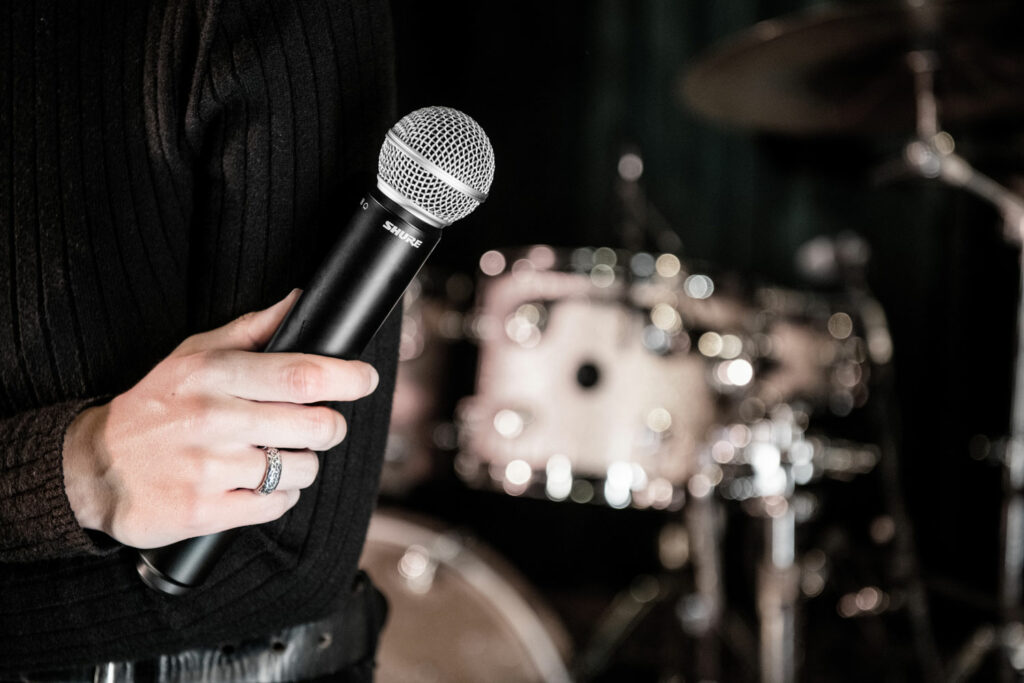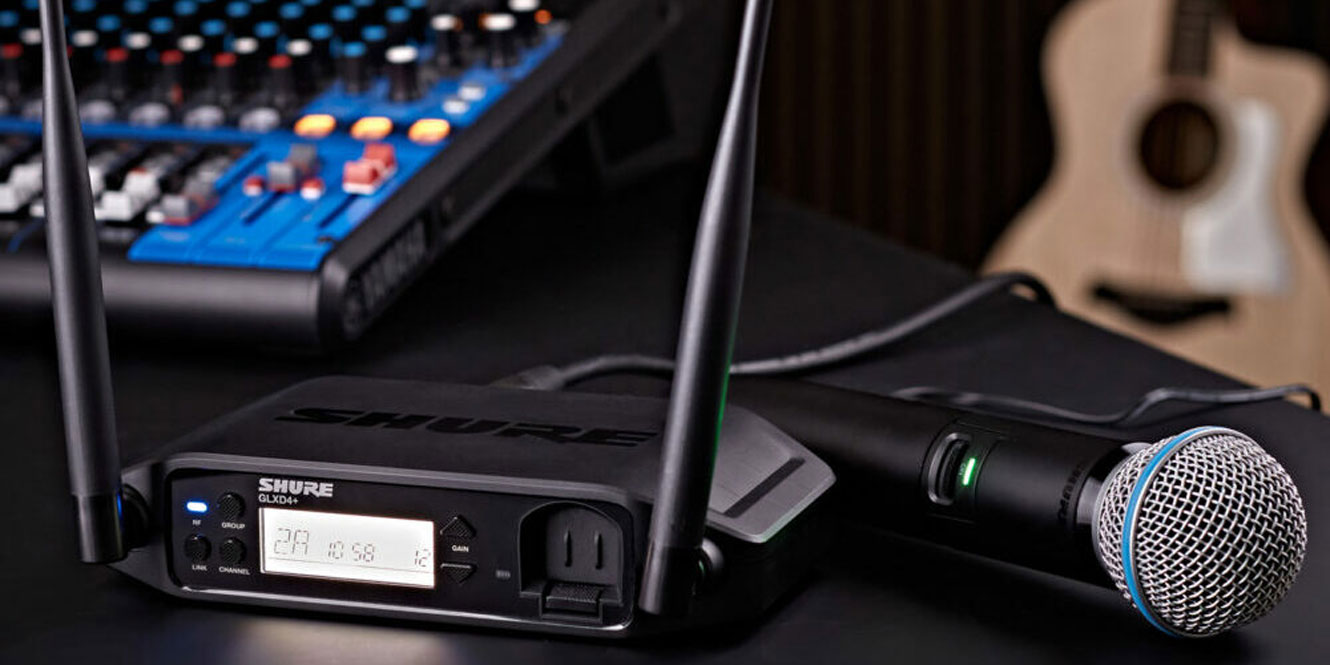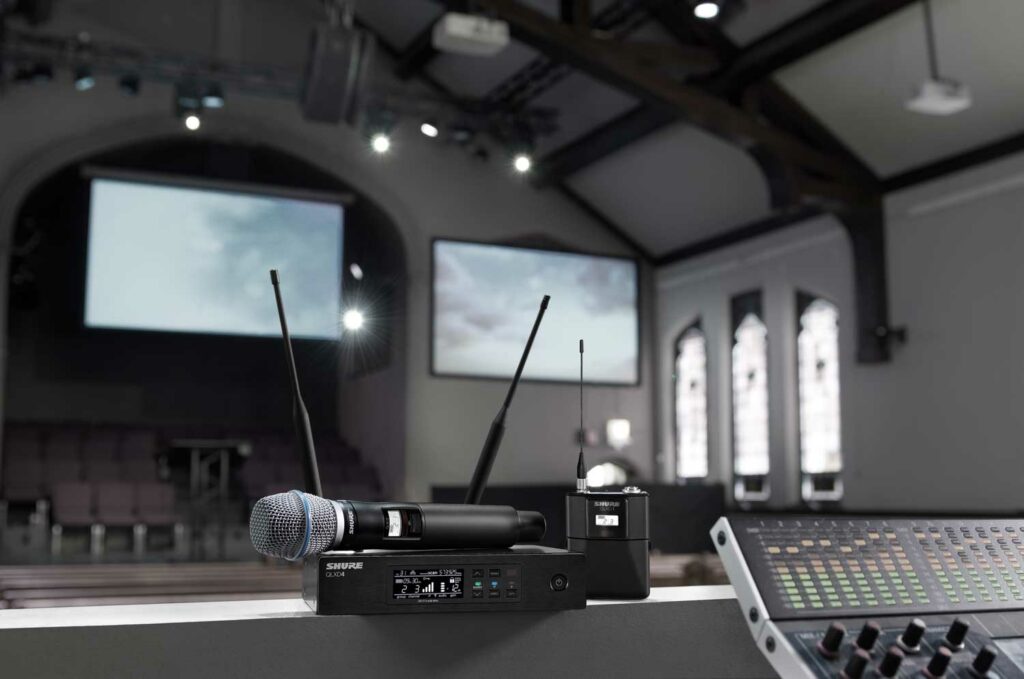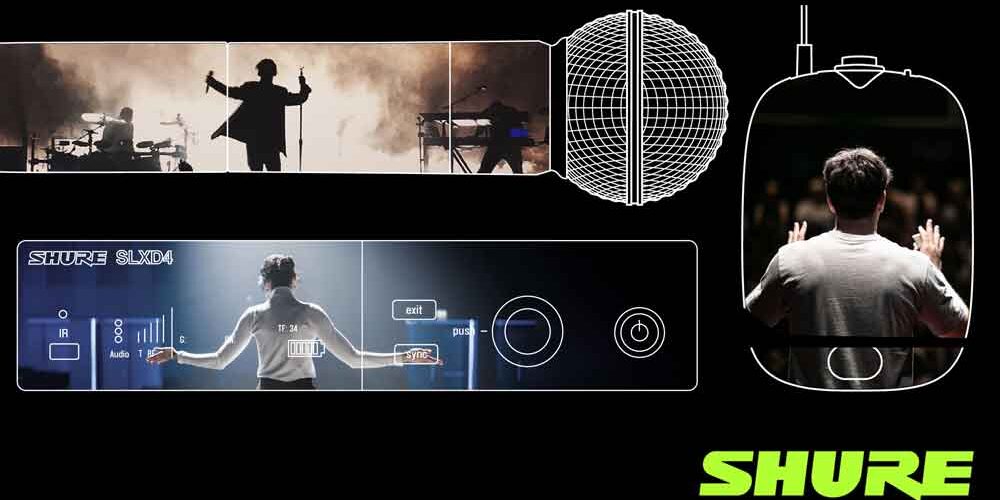If you’re in the market for a wireless system, Shure is the perfect brand to consider; it’s the go-to for many professionals. With nearly 100 years of history and a reputation for innovation in the music industry, Shure offers wireless systems tailored to singers, guitarists, public speakers, fitness instructors, and content creators.
The best systems at a glance
| Best System for Singers | GLXD24+/B87A |
| Best System for Guitarists | GLXD16+ |
| Best System for Public Speaking/Presenting | BLX14/W85 |
| Best System for Musical Theatre | QLXD14/153T-K51 |
| Best System for Fitness Instructors | GLXD14+/SM31 |
| Best Microphone System for Instruments | SLXD14/98H |
| Best Dual System | SLXD24D/SM58 |
| Most Budget Friendly System for Singers | BLX24/B58 |
| Most Budget Friendly System for Guitarists | BLX14R |
Understanding Shure Wireless Systems
Before knowing which Shure Wireless System is right for you, it’s best to understand how wireless technology works and why Shure is the top choice when it comes to wireless systems.
At live shows and events, usually, the microphone is the starting point for picking up sound signals. Anything that happens after this point will affect the show and the experience the audience has.
The people at Shure work to provide wireless systems that are able to perform in demanding environments.
As the world becomes more connected through wireless devices, such as mobiles, tablets, laptops, wifi systems, and even cars, the wireless spectrum that these devices can work on is becoming narrower. This means that “operating space” for wireless microphones may be challenging to find.
To be sure that wireless microphones can work correctly, without any dropouts or interference, Shure are constantly researching and developing wireless technology, providing the best wireless experience possible.
Wireless microphones run in dedicated blocks of the wireless frequency spectrum. In the UK, most wireless systems work on “UHF (ultra-high-frequency) Bands”.
However, there are some other parts of the spectrum that wireless can work on:
- TV Channel 38 – Operates on frequencies 606-614MHz. A license is required within the UK to operate wireless microphones in Channel 38. This includes the K3E, K59 and K51 systems that Shure offer.
- The Duplex Gap – Operates on frequencies of 823 – 832 MHz and is available for use as part of the Channel 38 license. This includes the S8 systems that Shure offer.
- 4GHz band – Available across the entire world for free. No licence is required. This includes the GLX-D range.
- 863 – 865 MHz – Another free-to-use frequency that does not require a licence. This includes the T11 systems that Shure offer.
- TV Channels 21 – 37 – Operate on frequencies 470-606MHz. TV channels 39 – 60 – operate on frequencies 614MHz-790MHz. These channels are available for wireless microphones on an interleaved basis. “Interleaved” refers to how we share the frequency space with existing digital TV channels. This means the microphones can operate in the gaps – sometimes called “white space” – between each TV channel. These frequencies are usually used for large events; you will require a licence for legal operation.
Shure BLX
Entry level wireless
BLX is the entry point for those who are completely new to wireless systems.
It’s incredibly easy to set up due to its one-touch Quickscan technology that helps you find an open frequency to use.
BLX systems also have a variety of microphone capsules to choose from, such as classics like the SM58 and Beta58, or you can choose body packs that can be used for headset microphones and instruments.
If you’re a beginner looking for an easy wireless system that works straight out of the box – and provides high-quality audio – then BLX is perfect for you.
What frequency should I choose?
BLX Systems are available in a number of different frequency bands. We have outlined the ones we currently offer at Gear4Music.
In the UK, K3E is the best choice as this is the primary frequency for UK and Ireland.
For use in central Europe, the best choice will be either T11, S8, or H3E, depending on the frequency laws within the country you wish to use wireless in. Some countries may require a license for legal operation.
K3E frequency (606-614MHz) is perfect for UK use. Please note that this frequency requires a license to operate legally.
S8 frequency (823-832MHz) may require a license depending on your area.
T11 frequency (863-865MHz) is license-free for most of Europe.
H3E frequency (518 – 542MHz) requires a license in the UK but is free to use in some European countries.
Shop now | Shure BLX Wireless Systems

Shure GLX-D+
Simple set up, extraordinary sound
The Shure GLX-D+ is one of the most reliable digital wireless systems out there thanks to the new dual-band frequencies feature. It can operate within 2.4 GHz and 5.8 GHz frequency bands at the same time, giving you a large spectrum to work in with little to no interference.
But what’s the benefit of a digital system? Well, it provides higher quality audio as it does not compress the audio that’s taken in.
All GLX-D+ systems come with a rechargeable lithium-ion battery which can last up to 16 hours, so there’s no need to buy any more AA batteries.
The system comes in a range of forms, such as guitar pedals, rack units, and desktop units, meaning there’s a perfect GLX-D+ system out there for you.
WHAT FREQUENCY SHOULD I CHOOSE?
The GLX-D+ Systems are completely license free, so you can perform pretty much anywhere without a license.
Shop now | Shure GLX-D+ Wireless Systems

Shure SLX-D
Reliable, high-quality digital audio
SLX-D offers outstanding quality in sound, build, and usability. The SLX-D system can maintain a stable signal which makes it reliable for your performance – there’ll be little to no dropouts.
It also produces crystal-clear audio with a super wide dynamic range which provides natural sound for both instruments and vocals. Even though this is a higher-end system, Shure has made it super easy to set up and use via the RF scan and IR sync buttons on the receiver.
SLX-D handheld transmitters have interchangeable capsules meaning you can swap out your sound whenever you feel like it.
If you’re a touring musician that needs a high level of audio quality and want to be sure there’ll be no dropouts or interference, SLX-D is all you need.
What frequency should I choose?
SLX-D is available in several different frequency bands.
In the UK, K59 is the recommended frequency. This frequency band sits within Channel 38 but also covers a wider range for use at larger events. A license is required for this frequency within the UK.
S50 and H56 are the recommended frequencies for use in Europe. Licenses may be required depending on your area.
Shop now | Shure SLX-D Wireless Systems

Shure QLX-D
Accurate, crystal-clear sound
QLX-D has a wide frequency bandwidth. This means that, even in areas with “crowded” frequencies, your system will be able to find a free slot – so you don’t need to spend ages “tuning” your system.
Setting up a single microphone is fast and easy – the built-in IR sync between the transmitter and receiver lets you instantly pair them together without scrolling through system menus.
The QLX-D system is perfect for someone who needs to set up multiple wireless microphones. You can connect up to 22 systems using the ethernet port on the receiver to create a network.
This network will automatically sync all systems together so that they don’t cross over, giving you the best wireless audio quality possible with no dropouts.
QLX-D is the perfect system for someone who needs exceptionally detailed audio in demanding environments. It’s ideal for touring musicians, places of worship, and educational establishments.
What frequency should I choose?
Just like the other Shure wireless products, QLX-D is available in several wireless frequencies.
For use in the UK, we recommend the K51, which sits in Channel 38 – 44. This extended range means QLX offers a wide range of frequencies so that there will never be any interference. A licence is required to operate legally.
H51 and S50 are the best choices for European countries. A license may be required for use, depending on your area.
Shop now | Shure QLX-D Wireless Systems

Wireless FAQs
Why do I need a wireless microphone license?
Some wireless systems, such as the GLX-D, don’t require a license. However, some systems will use frequencies that are part of a “shared” frequency spectrum.
To make sure that people are using the correct frequencies and that no one experiences any unwanted interference, a license will be required.
If you operate equipment without a license, you can face a fine or a prison sentence. Your equipment may also be seized. If you’re unsure whether you need a license, contact Ofcom for UK inquiries.
How does a wireless microphone system work?
A wireless microphone system is more than just the microphone you hold and sing into. It includes a transmitter (the microphone) and receiver.
When you sing into the microphone or when any sound is picked up, it converts the sound waves into an electrical signal, the transmitter then converts this signal into radio waves.
The receiver picks up these radio waves and turns the signal back into an electrical one, which can then go into a mixing desk or speakers so that you hear your vocals through the speakers.
Why should I use Shure wireless systems?
Shure have been making microphones for almost 100 years. They’re the industry leaders.
In the early days of Shure, they built microphones for the US army during World War 2. They had to make the microphones incredibly durable, rugged, and reliable.
Now, Shure still build their products to the same quality, so you know they’re a brand you can rely on.
If you’re on tour or even just beginning to use wireless microphones, Shure wireless microphones offer high build quality as well as amazing audio quality.
How do I set up a Shure wireless microphone system?
One of the best things about all Shure Wireless systems is that they are incredibly easy to set up.
It doesn’t matter if you are a beginner or a veteran pro, when it comes to setting up wireless microphone systems, Shure have made it as stress-free as possible.
The BLX system works straight out of the box- there’s no need to pair the microphone to the receiver. The receiver will locate the microphone automatically, meaning all you need to do is power on the system and connect your audio cable to your mixer or speaker.
On systems like SLX-D and QLX-D, there’s an IR sync option, which allows you to hold the microphone up to the receiver which will pair them for you.
All Shure Wireless Systems use RF scan that will automatically scan the radio frequencies for a clear channel to use, meaning there’ll be no dropouts or interference during your performance.
Find out more
Now that you’re all clued up, why not check out the full range of Shure Wireless Systems?













0 Comments